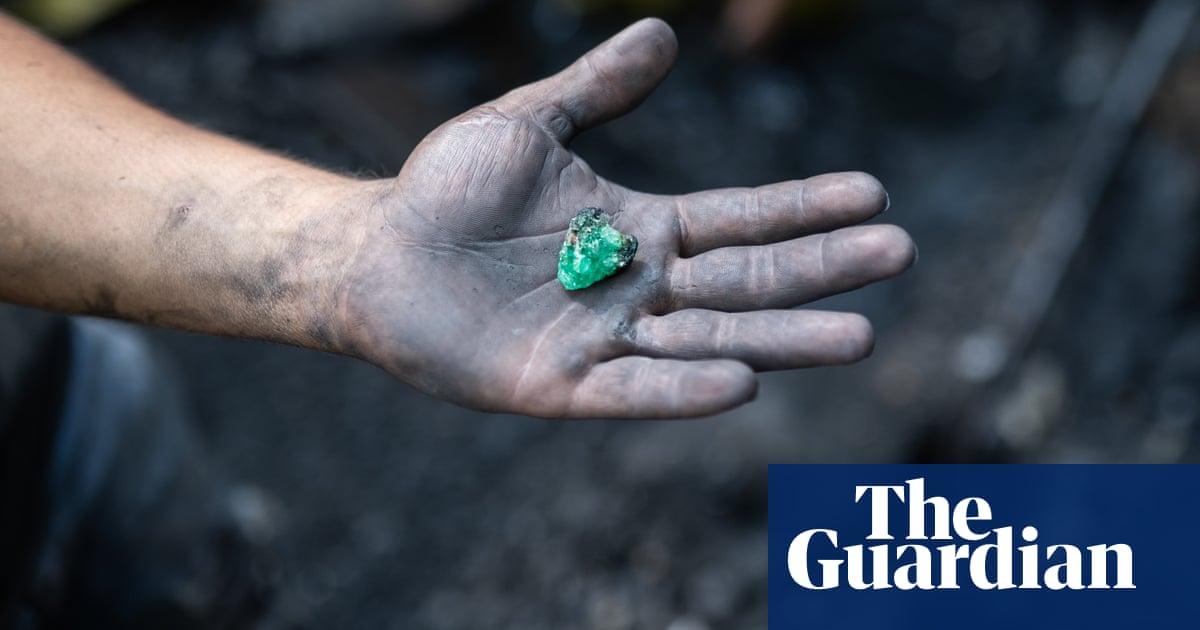The small town of Muzo, nestled deep in Colombia’s emerald-rich valleys of Boyacá province, is a place where the soil holds great wealth. Brick-red homes and tin-roof shacks cling to the mountainside, their bases resting on black sand and dark mud. Below, the Río Minero weaves through the valley, its waters tainted by the silt and debris of continuous excavation.
The region’s natural beauty is marred by scattered waste and discarded mining materials, evidence of an industry that supports the town’s economy – but also harms its environment.
Muzo, known by local people as the emerald capital of the world, has been at the centre of Colombia’s tumultuous, profitable and frequently perilous trade in the precious stones for decades.
Colombia is a global leader in emerald production. According to Colombian authorities, it is the world’s largest producer and reportedly accounts for 55% of the global market. Muzo’s emeralds are highly prized for their quality and intense colour, generating approximately $150m (£113m) in annual sales.
Yet, the valleys surrounding Muzo are grappling with the environmental cost of mining: polluted water and dangerous erosion. In a region exploited by authorised mining companies and informal operators, the two parties blame one another.
Informal emerald mining is widely practised by local people in search of a livelihood. By the river, older men and women wade knee-deep in the water, their shovels driving into the sand in search of the green gems. This type of mining is known locally as guaquería, which typically entails sifting through the leftover soil and debris that mining companies leave behind.
“We toil with the hope of discovering an emerald during our journey or amid the land supplied by the companies,” says María (not her real name), a guaquera who lives in Muzo. “That’s how we make a living.”
Many guaqueros rely on a traditional event called “la voladora”, during which, several times a month, a small, caged corridor is filled with discarded mining debris that people rush to sift through in search of hidden gems. “It’s unregulated work,” María says.
Still, researchers suggest that blaming environmental devastation exclusively on the guaqueros might be a mistake. Quantifying the damage is challenging due to a lack of data, but a 2018 study from El Bosque University in Bogotá found that 29% of the environmental burden of industrial emerald extraction is down to deforestation, while the use of explosives accounts for about 22%.
Deforestation and use of explosives are widespread among mining companies.
“Compared with other types of mining, underground mining in general does not generate much impact,” says Roger Buitrago, the manager for health, security and environment at the Puerto Arturo mine in Muzo, run by the Colombian company Esmeraldas Mining Services (EMS). “Our main [environmental] impacts are basically deforestation and water management.”
Relentless extraction has transformed Muzo’s landscape. Along the riverbanks, hollowed-out pits dot the hillsides, and improvised tunnels extend into the dark rock – signs of artisanal mining. Further uphill, industrial-scale mining carves a path through the rolling mountains across the valley.
Local people say the most evident effect of mining – whether industrial or subsistence – is the pollution of their rivers.
A 2020 study led by the Pontifical Javeriana University revealed alarming pollution levels in local water bodies, including the Ítoco River and Las Ánimas creek. This contamination stems mainly from the unregulated disposal of mining byproducts and the authorities’ neglect of the problem.
Studies indicate that water pollution in Muzo mainly arises from sediment runoff, explosive residues, and potential mining-related hydrocarbon leaks. Although modern operations tend to avoid harsh chemicals, it is likely that past practices degraded water quality through waste disposal and the use of explosives.
Buitrago says that local rivers are “very polluted”. Yet, Colombia’s national emerald federation – Fedesmeraldas – claims the industry is mindful of its environmental obligations, as companies “must operate under strict mining and environmental standards”.
“Formal mining in Muzo demonstrates that it is possible to extract high-value resources such as emeralds in a sustainable way, when environmental standards are respected and the wellbeing of communities and ecosystems is prioritised,” Óscar Baquero, president of Fedesmeraldas, said in a statement. “This approach contributes to a greener and more inclusive economy in Colombia.”
Baquero and Buitrago identify guaqueros as the leading cause of contamination in the region. “Informal or illegal mining has a major negative impact on the environment and on the people who carry out the activity, as they do not have environmental impact studies nor management plans, and do not avoid, mitigate or compensate for the effects of their activity,” Baquero adds.
after newsletter promotion
Nonetheless, Buitrago also acknowledges that the regulations set out for the mining companies are mostly bureaucratic, and says he has never seen any representatives or state authorities policing the company’s environmental protection systems. “It is very important that [the state] defines and controls natural resources, because now we literally only have paper,” he says.
María, the guaquera, used to work at EMS’s Puerto Arturo mine. She spent two years in the sorting room, filtering through rocks and soil looking for emeralds. She alleges the mine mismanaged wastewater, dumping it into local streams.
“I saw that there was a lack of filtration to treat the water that came out of the mine. The water came out of the mine and went through a tank. We used that water to wash the earth that contained emeralds, and it was poured into the stream,” she says.
Buitrago denies this. “We have our duly authorised disposal points and have domestic wastewater treatment plants which are approved and authorised to be able to carry this out,” he says, adding that the company performs weekly and monthly internal checks, with external reviews every six months.
Local people have also accused the mining companies of deliberately shutting off their water treatment facilities when checks on operations are not being carried out, and as a cost-cutting measure. The Guardian was unable to verify such allegations independently.
The Guardian visited the mine but was denied access to the treatment facilities and mining operations and photography at the site was not permitted.
As illegal mining persists, usually with little oversight or environmental protection measures, guaqueros acknowledge their part in it. “We as guaqueros do a lot of damage to the environment, we generate a lot of waste,” María says. “As we don’t have anyone to regulate us, we don’t mind throwing plastics, tarps, lids and other things that end up in the river.”
While the responsibility for environmental destruction is disputed, the devastation is undeniable, as Muzo’s emerald industry has contributed to deforestation and soil erosion. Demand for new mining sites has resulted in forests being cleared, and tunnel digging destabilises the land.
A 2024 report from the National University of Colombia stated that underground excavation causes soil cracking, allowing surface water to seep into aquifers, which decreases water availability, destabilises the land and raises the risk of landslides.
Residents say such incidents are becoming increasingly common. On 5 April, two miners died in a tunnel collapse in the neighbouring town of Maripí.
While enforcement of regulations remains patchy, awareness of environmental challenges is increasing. As such, la voladora is now on hold, and local authorities plan to shut it down permanently to reduce pollution.
As the future of Muzo’s economy and environment depends on how policymakers, companies and communities address the challenges presented by the emerald industry, unchecked mining could inflict long-term harm on people and nature.
“We should not ignore that we have duties,” María says. “And one of our greatest duties is to protect water and the environment.”

